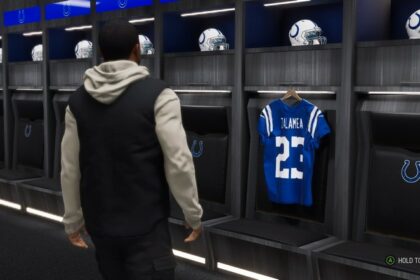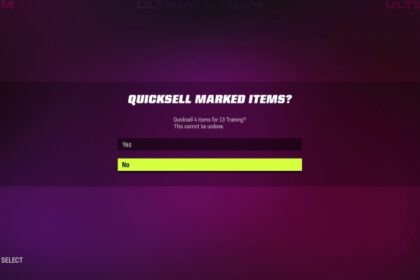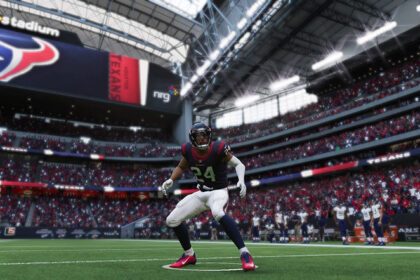In order to build a team that has long-term success in Madden 23, making good use of the draft is a must.
The draft allows you to bring in talented young players to boost your franchise without having to shell out the money and cap space you would for a talented free agent.
Of course, this means you have to be smart throughout every step of the scouting process – from the very first look at the incoming players all the way up until the draft has concluded – in order to get the most impact-making players you can.
This guide discusses the best scouting tips for Madden 23 Franchise Mode. Applying these tips will ensure that your team can reach the top level and stay there for years to come.
Starting the Scouting Process (Week 1)
The scouting process for the draft begins in week 1 of the regular season. This is when you’ll both choose your draft class as well as hire/assign your scouts. Both of these can be selected from the home screen of the Franchise Mode menu.
Choosing your draft class is a simple choice from three options.
The first is “Keep Auto-Generated Rookies” which is exactly as it sounds: your draft class will be random players auto-generated by the game.
The second option is “Download from Madden Share”, which allows you to download a draft class that someone else has made and import it into your franchise.
Finally, if you’d like to use a custom draft class that you’ve already downloaded, you can select that class by choosing “Import Local Files”.

Next, you’ll want to hire and assign your scouts for the season.
Each scout has a different position of specialty and a different level of talent, indicated by their tier (tier three is the best, tier one is the worst). You may only have one tier 3 scout, one tier 2 scout, and three tier 1 scouts.
When making your decision on which scouts to hire and where to assign them, you’ll want to take a look at the region breakdown. This screen will show you the class’s strengths and weaknesses in each region as well as nationally.

To get the most out of your scouts, it’d be ideal to set your tier 3 as the national scout so that their boosts can be used on as many prospects as possible.
Determine what positions are the most important needs for your team and use that information, combined with each region’s strengths, to hire and assign your scouts.
Each scout has two positions of expertise and you’ll receive the most scouting bonuses if you assign a scout to a region that has strengths in both. However, the strengths can sometimes line up in such a way that it isn’t always possible to do both. If you can’t line up two positions in a region, you will want to make sure you can match at least one.
Once you’ve chosen your draft class and scouts you can take your first look at the class’s prospects. These players will have little-to-no scouting completed on them in this stage, but you will be able to see basic information such as their talent projection, measurables, and scouting report/player notes.
As you progress through the scouting process over the course of the season you’ll gain more information on these prospects, such as individual ratings and their archetype for you to see if they’re a scheme fit for your offensive and defensive playbooks.

Once you’re satisfied with looking at the currently available information, you’re ready to move on in the scouting process.
Regional Focus Scouting and Mock Draft 1 (Week 3)
Your scouts will automatically scout for you as the season progresses (with the higher-tier scouts producing more information) without you needing to influence it.
You can check in on the prospects and any potential new info at any point in the season simply by selecting “scout college players” from the home tab.
After hiring and assigning your scouts in week 1, your next directly hands-on portion of the scouting process comes in week 3 with the regional focus scouting (which again, can be accessed from Franchise mode’s home tab, as can all upcoming stages of the scouting process).
The regional focus scouting in week 3 is where you’ll set in stone what position each regional scout should be focusing their best efforts on.
You do this by selecting “set focus scouting” on each of your regional scouts from the region breakdown screen and choosing the specific position that you’d like them to focus on.
Week 3 will also give you access to the season’s first mock draft. This is a prediction of what player each team will take based on their team needs and the available pool of prospects.

The mock drafts will get closer to accurate as the season progresses (there are five in total), but you can still get a vague idea of where players may be drafted based on the first one.
Do keep in mind that as the season isn’t over the draft order has not been finalized, so there is potential for major changes to happen to the mock draft over the course of the season.
Scouting National Focus and Mock Draft 2 (Week 8)
Following week 3, the only interaction with the scouting until week 8 that’s necessary is occasionally checking in to look more in-depth at the prospects as the scouting becomes more complete.
In week 8, you’ll be able to look at the second mock draft, which like mock draft 1 is still subject to change as the season goes on, it will give you more solid information as players have moved up and down since week 3.
Also in week 8, you’ll set the main focus for your national scout. Like the regional scouts in week 3, you do this by selecting “set focus scouting” on your national scout from the region breakdown screen.

Once you’ve set the focus for your national scout it’s back to letting your scouts do their thing and occasionally checking in on any new information on the class’ prospects they’ve uncovered for you.
Prospect Spotlight and Focus Scouting (Week 11)
Prospect Spotlight
In week 11 you’ll receive a prospect spotlight from your coaching staff. This triggers a cutscene of a staff member telling you that you should take a closer look at a specific prospect in the class.

Go ahead and take a look at the player that was suggested to assess their skills. Keep that player in mind going forward, as while it isn’t a guarantee, the player that is highlighted in this cutscene has a higher chance of having a development trait above normal (this also applies to any players you may see news stories on throughout the season).
Focus Scouting
Week 11 will also give you the chance to participate in focus scouting. In this stage, you’ll select three prospects that you want a more in-depth look at.

For focus scouting, it’s best to choose intriguing players that you don’t already have a lot of scouting done on. This is because a player that’s already 95% scouted only has 5% more you can learn, while a player sitting at 50% has an entire 50% of new information for you to uncover.
Once you’ve completed the focus scouting, the scouting process will be hands-off (besides the continued checking in on new information) until the offseason comes around.
Combine Results and Mock Draft 3
The third mock draft will become available to you in the first stage of the offseason, immediately following Super Bowl Week. This mock draft can provide by far the most valuable info so far, as it’s the first where the team’s draft positions have been finalized.
In the next stage of the offseason (free agency 1) you’ll be able to view the combine results for the prospects.

While there are no new direct actions for you to take at this stage, you can gain valuable information from looking at the players’ combine results such as a general idea of their speed, strength, agility, etc.
College Pro Day Results and Mock Draft 4
The following stage of the offseason (free agency 2) comes with the fourth mock draft for you to look at. Given how little has changed since the third mock, this will be reflected by how similar they are (this goes for the upcoming mock draft 5 as well).
Mock drafts 3 through 5 will stay relatively the same, but any changes that do happen also hold more wait as we get closer and closer to draft day.
This offseason stage also provides you with the prospects’ college pro day results.

The college pro day gives you the results on the same drills that you received from the combine results.
The college pro day serves as a sort of confirmation of the player’s attributes, as similar results across the college pro day and combine results suggest that said result is accurate, while a difference in the two should make you consider how accurate the assessment of a player’s ability is.
Private Workouts
The last asset available to you in the scouting process is private workouts, which come in the last offseason stage right before the draft (free agency recap).
In the private workouts, you’re able to choose another three players that you’d like to see in-depth information on. Like focus scouting before, it’s smart to choose players who have less scouting already completed, as you’ll gain more information from the private workout.
Once you’ve completed the private workouts, your scouting actions are complete! All that’s left to do now is look at all the information you’ve gathered on the prospects, formulate a plan, and start the draft!
Final Word
The scouting process in Madden 23 is simple and easy to use. However, if you’re aware of the best scouting tips for Madden 23 Franchise mode, you can greatly improve the process for yourself and increase your chances of drafting the next star player to take over the league.
Speaking of drafts, if you’re looking to start a fantasy draft in Franchise Mode, click that link and check out the guide we put together for it.






